Market Analysis: Higher Education Collaboration in Oman & Cyprus
VerifiedAdded on 2020/06/05
|60
|11522
|365
Thesis and Dissertation
AI Summary
This thesis examines the market analysis of Omani third-level education services, exploring the challenges and opportunities for foreign universities operating in Oman and recruiting students. The research investigates the collaboration between universities, focusing on market analysis, challenges related to language and cultural barriers, and strategies for student recruitment. The study employs a mixed-methods approach, gathering data from managers and administrators of international universities through questionnaires. The thesis provides insights into the reasons for selecting Oman, the strategies employed, and the challenges faced by foreign universities. It delves into the impact of cultural differences, technological advancements, and funding issues on the establishment and operation of educational institutions. The findings highlight the importance of market analysis, collaboration, and adaptation to local contexts for successful internationalization of higher education, offering recommendations for universities seeking to expand their presence in Oman and similar regions.
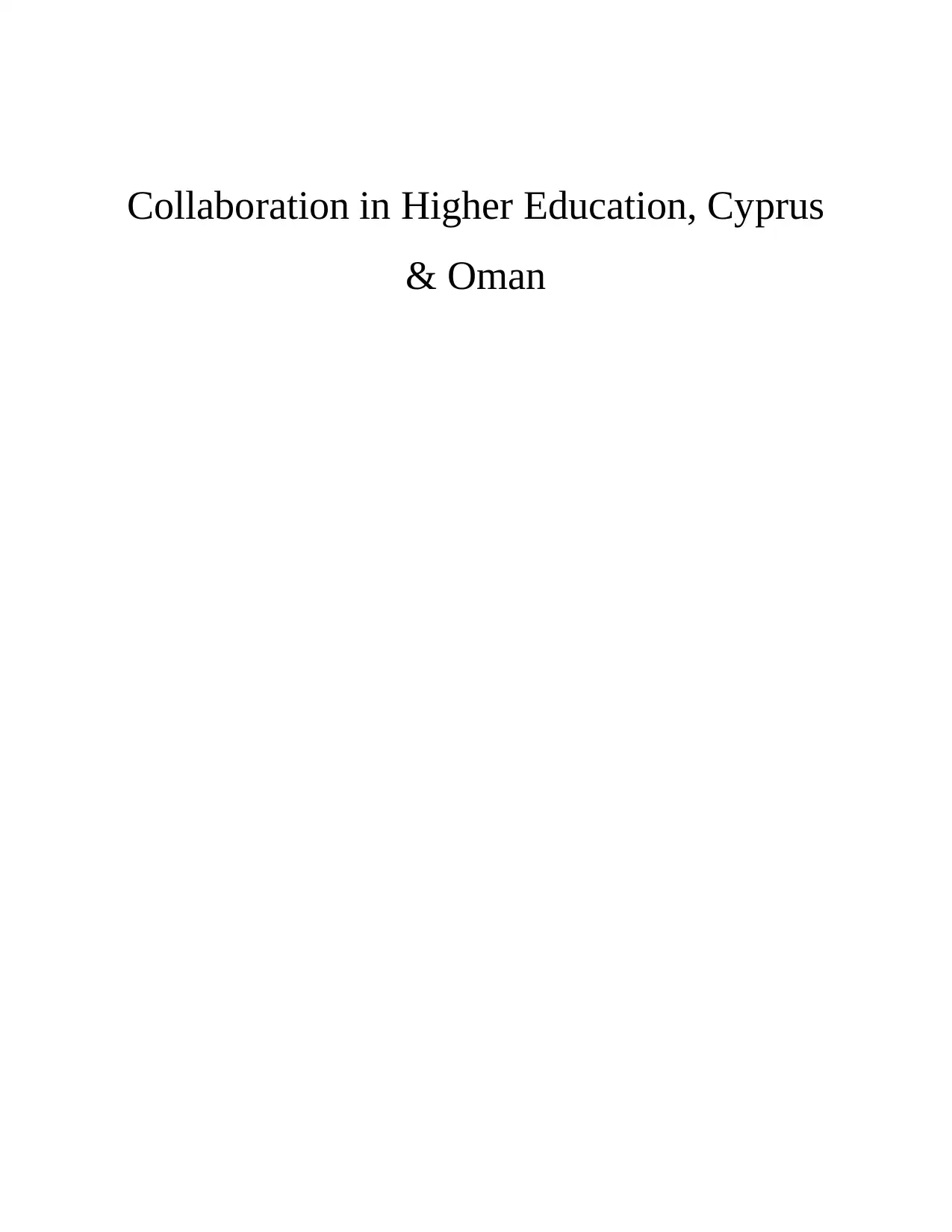
Collaboration in Higher Education, Cyprus
& Oman
& Oman
Paraphrase This Document
Need a fresh take? Get an instant paraphrase of this document with our AI Paraphraser
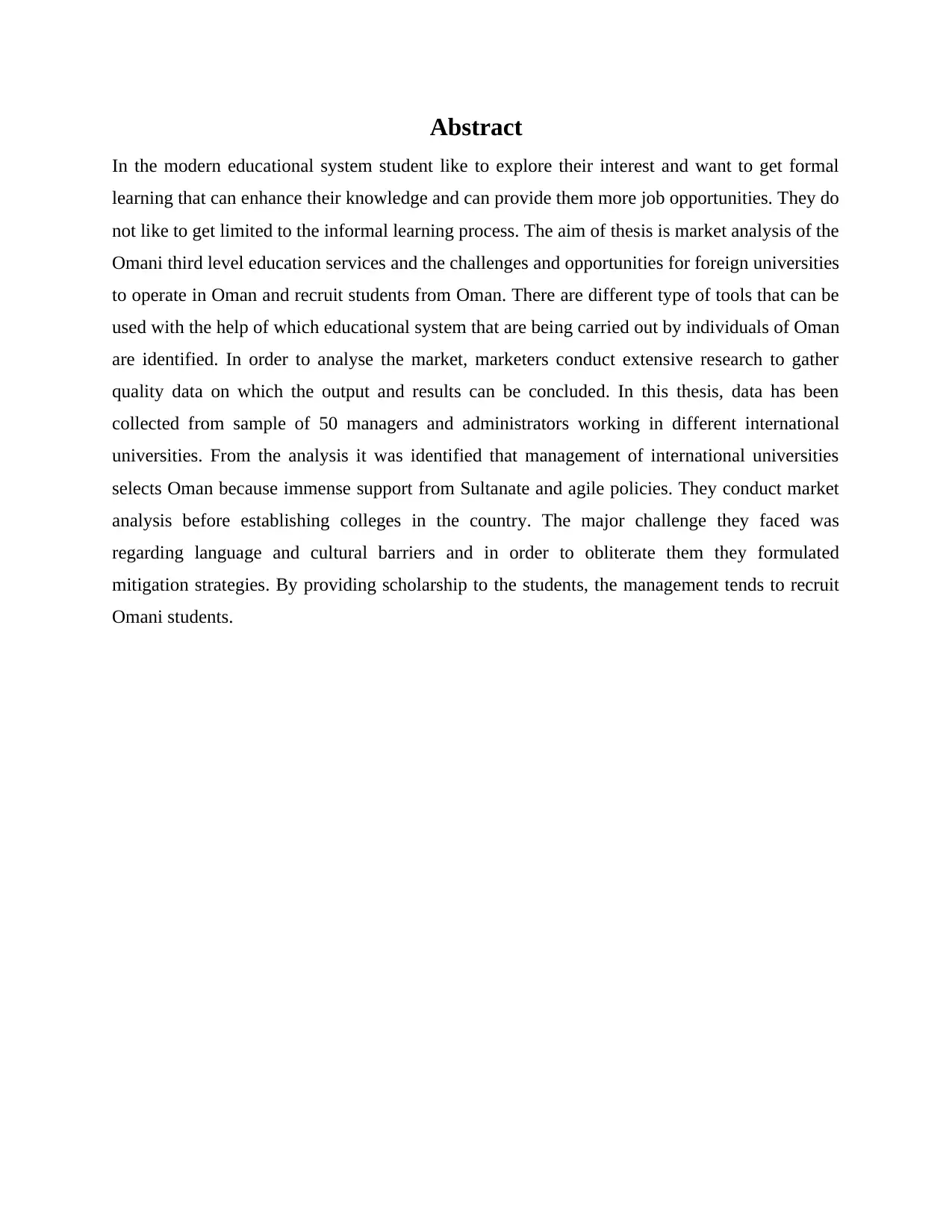
Abstract
In the modern educational system student like to explore their interest and want to get formal
learning that can enhance their knowledge and can provide them more job opportunities. They do
not like to get limited to the informal learning process. The aim of thesis is market analysis of the
Omani third level education services and the challenges and opportunities for foreign universities
to operate in Oman and recruit students from Oman. There are different type of tools that can be
used with the help of which educational system that are being carried out by individuals of Oman
are identified. In order to analyse the market, marketers conduct extensive research to gather
quality data on which the output and results can be concluded. In this thesis, data has been
collected from sample of 50 managers and administrators working in different international
universities. From the analysis it was identified that management of international universities
selects Oman because immense support from Sultanate and agile policies. They conduct market
analysis before establishing colleges in the country. The major challenge they faced was
regarding language and cultural barriers and in order to obliterate them they formulated
mitigation strategies. By providing scholarship to the students, the management tends to recruit
Omani students.
In the modern educational system student like to explore their interest and want to get formal
learning that can enhance their knowledge and can provide them more job opportunities. They do
not like to get limited to the informal learning process. The aim of thesis is market analysis of the
Omani third level education services and the challenges and opportunities for foreign universities
to operate in Oman and recruit students from Oman. There are different type of tools that can be
used with the help of which educational system that are being carried out by individuals of Oman
are identified. In order to analyse the market, marketers conduct extensive research to gather
quality data on which the output and results can be concluded. In this thesis, data has been
collected from sample of 50 managers and administrators working in different international
universities. From the analysis it was identified that management of international universities
selects Oman because immense support from Sultanate and agile policies. They conduct market
analysis before establishing colleges in the country. The major challenge they faced was
regarding language and cultural barriers and in order to obliterate them they formulated
mitigation strategies. By providing scholarship to the students, the management tends to recruit
Omani students.
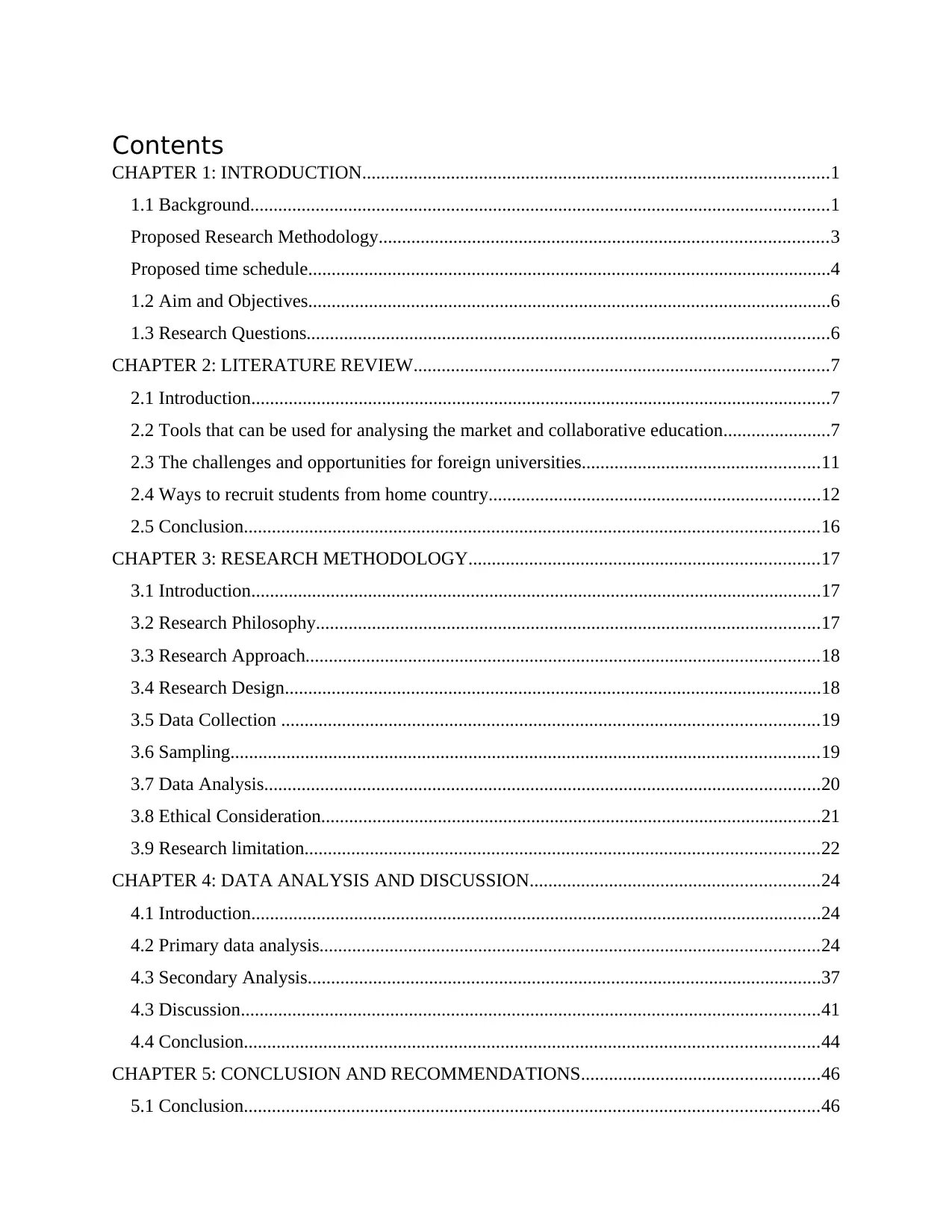
Contents
CHAPTER 1: INTRODUCTION....................................................................................................1
1.1 Background............................................................................................................................1
Proposed Research Methodology................................................................................................3
Proposed time schedule................................................................................................................4
1.2 Aim and Objectives................................................................................................................6
1.3 Research Questions................................................................................................................6
CHAPTER 2: LITERATURE REVIEW.........................................................................................7
2.1 Introduction............................................................................................................................7
2.2 Tools that can be used for analysing the market and collaborative education.......................7
2.3 The challenges and opportunities for foreign universities...................................................11
2.4 Ways to recruit students from home country.......................................................................12
2.5 Conclusion...........................................................................................................................16
CHAPTER 3: RESEARCH METHODOLOGY...........................................................................17
3.1 Introduction..........................................................................................................................17
3.2 Research Philosophy............................................................................................................17
3.3 Research Approach..............................................................................................................18
3.4 Research Design...................................................................................................................18
3.5 Data Collection ...................................................................................................................19
3.6 Sampling..............................................................................................................................19
3.7 Data Analysis.......................................................................................................................20
3.8 Ethical Consideration...........................................................................................................21
3.9 Research limitation..............................................................................................................22
CHAPTER 4: DATA ANALYSIS AND DISCUSSION..............................................................24
4.1 Introduction..........................................................................................................................24
4.2 Primary data analysis...........................................................................................................24
4.3 Secondary Analysis..............................................................................................................37
4.3 Discussion............................................................................................................................41
4.4 Conclusion...........................................................................................................................44
CHAPTER 5: CONCLUSION AND RECOMMENDATIONS...................................................46
5.1 Conclusion...........................................................................................................................46
CHAPTER 1: INTRODUCTION....................................................................................................1
1.1 Background............................................................................................................................1
Proposed Research Methodology................................................................................................3
Proposed time schedule................................................................................................................4
1.2 Aim and Objectives................................................................................................................6
1.3 Research Questions................................................................................................................6
CHAPTER 2: LITERATURE REVIEW.........................................................................................7
2.1 Introduction............................................................................................................................7
2.2 Tools that can be used for analysing the market and collaborative education.......................7
2.3 The challenges and opportunities for foreign universities...................................................11
2.4 Ways to recruit students from home country.......................................................................12
2.5 Conclusion...........................................................................................................................16
CHAPTER 3: RESEARCH METHODOLOGY...........................................................................17
3.1 Introduction..........................................................................................................................17
3.2 Research Philosophy............................................................................................................17
3.3 Research Approach..............................................................................................................18
3.4 Research Design...................................................................................................................18
3.5 Data Collection ...................................................................................................................19
3.6 Sampling..............................................................................................................................19
3.7 Data Analysis.......................................................................................................................20
3.8 Ethical Consideration...........................................................................................................21
3.9 Research limitation..............................................................................................................22
CHAPTER 4: DATA ANALYSIS AND DISCUSSION..............................................................24
4.1 Introduction..........................................................................................................................24
4.2 Primary data analysis...........................................................................................................24
4.3 Secondary Analysis..............................................................................................................37
4.3 Discussion............................................................................................................................41
4.4 Conclusion...........................................................................................................................44
CHAPTER 5: CONCLUSION AND RECOMMENDATIONS...................................................46
5.1 Conclusion...........................................................................................................................46
⊘ This is a preview!⊘
Do you want full access?
Subscribe today to unlock all pages.

Trusted by 1+ million students worldwide
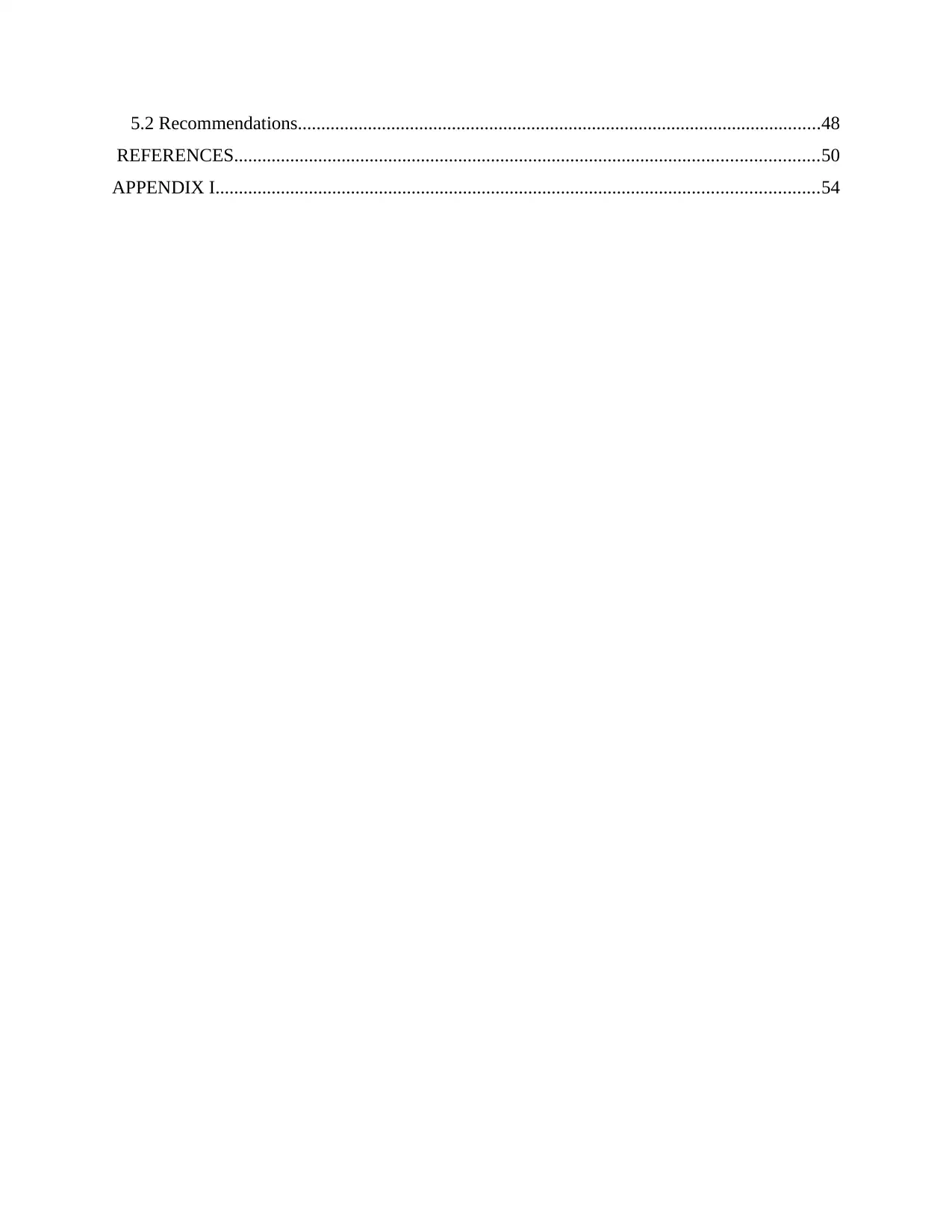
5.2 Recommendations................................................................................................................48
REFERENCES.............................................................................................................................50
APPENDIX I.................................................................................................................................54
REFERENCES.............................................................................................................................50
APPENDIX I.................................................................................................................................54
Paraphrase This Document
Need a fresh take? Get an instant paraphrase of this document with our AI Paraphraser
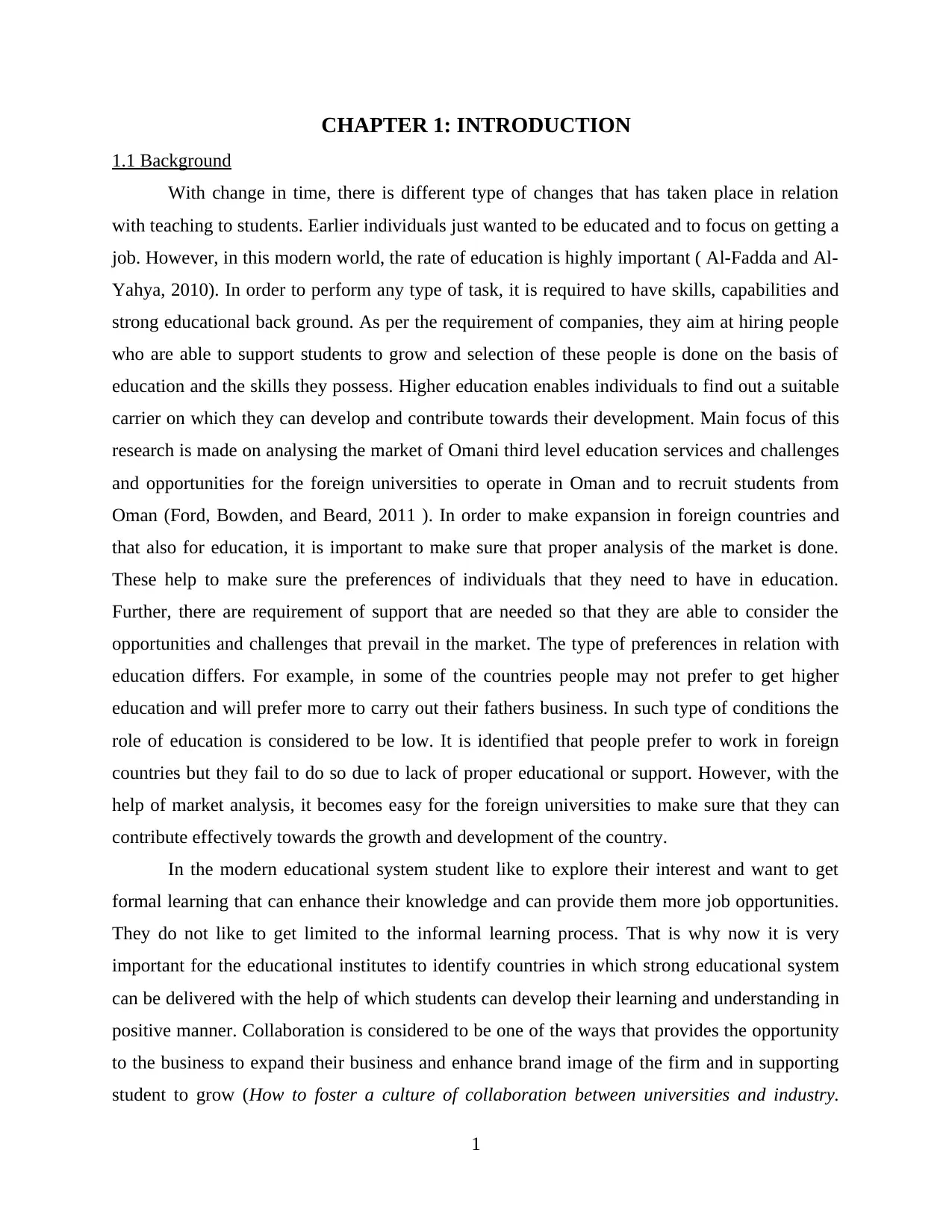
CHAPTER 1: INTRODUCTION
1.1 Background
With change in time, there is different type of changes that has taken place in relation
with teaching to students. Earlier individuals just wanted to be educated and to focus on getting a
job. However, in this modern world, the rate of education is highly important ( Al-Fadda and Al-
Yahya, 2010). In order to perform any type of task, it is required to have skills, capabilities and
strong educational back ground. As per the requirement of companies, they aim at hiring people
who are able to support students to grow and selection of these people is done on the basis of
education and the skills they possess. Higher education enables individuals to find out a suitable
carrier on which they can develop and contribute towards their development. Main focus of this
research is made on analysing the market of Omani third level education services and challenges
and opportunities for the foreign universities to operate in Oman and to recruit students from
Oman (Ford, Bowden, and Beard, 2011 ). In order to make expansion in foreign countries and
that also for education, it is important to make sure that proper analysis of the market is done.
These help to make sure the preferences of individuals that they need to have in education.
Further, there are requirement of support that are needed so that they are able to consider the
opportunities and challenges that prevail in the market. The type of preferences in relation with
education differs. For example, in some of the countries people may not prefer to get higher
education and will prefer more to carry out their fathers business. In such type of conditions the
role of education is considered to be low. It is identified that people prefer to work in foreign
countries but they fail to do so due to lack of proper educational or support. However, with the
help of market analysis, it becomes easy for the foreign universities to make sure that they can
contribute effectively towards the growth and development of the country.
In the modern educational system student like to explore their interest and want to get
formal learning that can enhance their knowledge and can provide them more job opportunities.
They do not like to get limited to the informal learning process. That is why now it is very
important for the educational institutes to identify countries in which strong educational system
can be delivered with the help of which students can develop their learning and understanding in
positive manner. Collaboration is considered to be one of the ways that provides the opportunity
to the business to expand their business and enhance brand image of the firm and in supporting
student to grow (How to foster a culture of collaboration between universities and industry.
1
1.1 Background
With change in time, there is different type of changes that has taken place in relation
with teaching to students. Earlier individuals just wanted to be educated and to focus on getting a
job. However, in this modern world, the rate of education is highly important ( Al-Fadda and Al-
Yahya, 2010). In order to perform any type of task, it is required to have skills, capabilities and
strong educational back ground. As per the requirement of companies, they aim at hiring people
who are able to support students to grow and selection of these people is done on the basis of
education and the skills they possess. Higher education enables individuals to find out a suitable
carrier on which they can develop and contribute towards their development. Main focus of this
research is made on analysing the market of Omani third level education services and challenges
and opportunities for the foreign universities to operate in Oman and to recruit students from
Oman (Ford, Bowden, and Beard, 2011 ). In order to make expansion in foreign countries and
that also for education, it is important to make sure that proper analysis of the market is done.
These help to make sure the preferences of individuals that they need to have in education.
Further, there are requirement of support that are needed so that they are able to consider the
opportunities and challenges that prevail in the market. The type of preferences in relation with
education differs. For example, in some of the countries people may not prefer to get higher
education and will prefer more to carry out their fathers business. In such type of conditions the
role of education is considered to be low. It is identified that people prefer to work in foreign
countries but they fail to do so due to lack of proper educational or support. However, with the
help of market analysis, it becomes easy for the foreign universities to make sure that they can
contribute effectively towards the growth and development of the country.
In the modern educational system student like to explore their interest and want to get
formal learning that can enhance their knowledge and can provide them more job opportunities.
They do not like to get limited to the informal learning process. That is why now it is very
important for the educational institutes to identify countries in which strong educational system
can be delivered with the help of which students can develop their learning and understanding in
positive manner. Collaboration is considered to be one of the ways that provides the opportunity
to the business to expand their business and enhance brand image of the firm and in supporting
student to grow (How to foster a culture of collaboration between universities and industry.
1
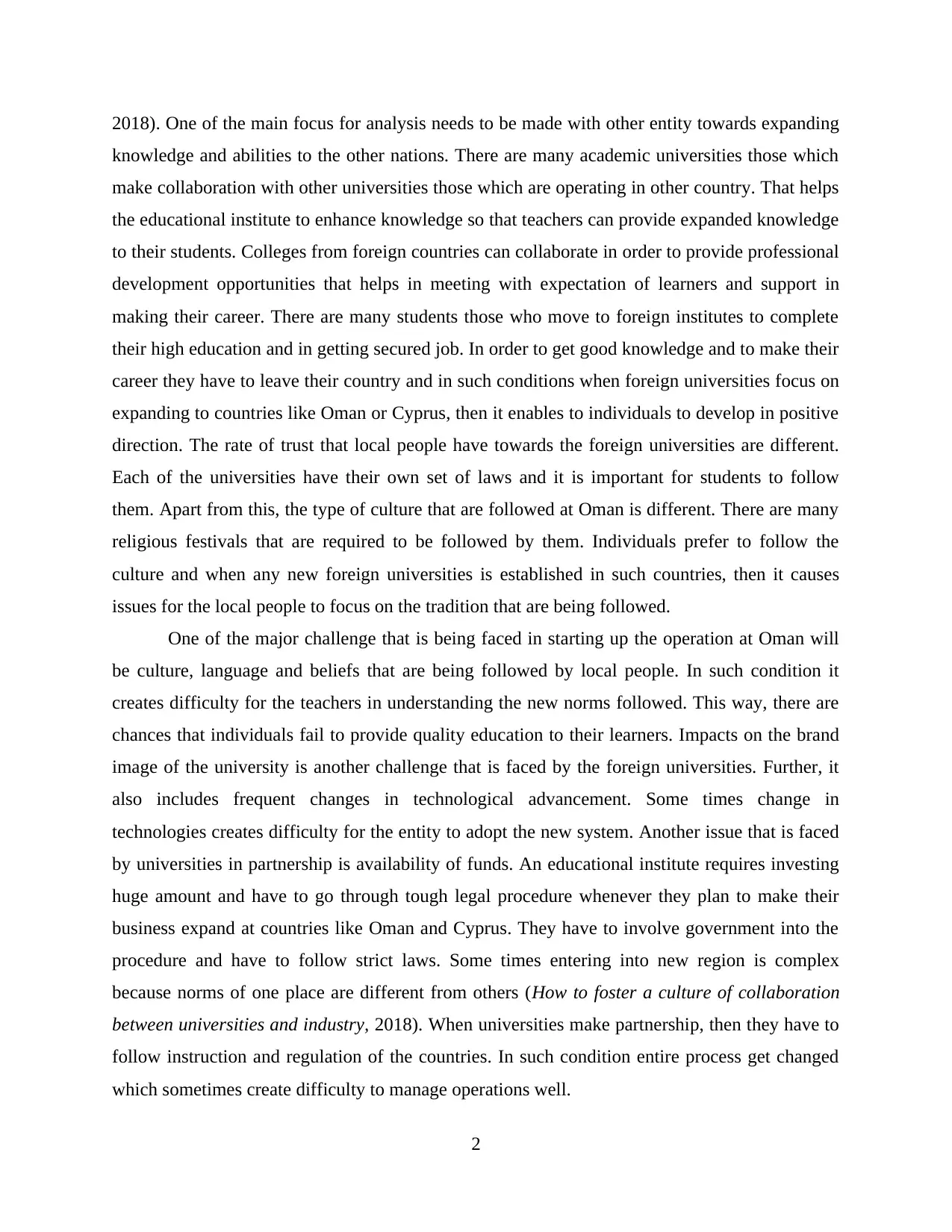
2018). One of the main focus for analysis needs to be made with other entity towards expanding
knowledge and abilities to the other nations. There are many academic universities those which
make collaboration with other universities those which are operating in other country. That helps
the educational institute to enhance knowledge so that teachers can provide expanded knowledge
to their students. Colleges from foreign countries can collaborate in order to provide professional
development opportunities that helps in meeting with expectation of learners and support in
making their career. There are many students those who move to foreign institutes to complete
their high education and in getting secured job. In order to get good knowledge and to make their
career they have to leave their country and in such conditions when foreign universities focus on
expanding to countries like Oman or Cyprus, then it enables to individuals to develop in positive
direction. The rate of trust that local people have towards the foreign universities are different.
Each of the universities have their own set of laws and it is important for students to follow
them. Apart from this, the type of culture that are followed at Oman is different. There are many
religious festivals that are required to be followed by them. Individuals prefer to follow the
culture and when any new foreign universities is established in such countries, then it causes
issues for the local people to focus on the tradition that are being followed.
One of the major challenge that is being faced in starting up the operation at Oman will
be culture, language and beliefs that are being followed by local people. In such condition it
creates difficulty for the teachers in understanding the new norms followed. This way, there are
chances that individuals fail to provide quality education to their learners. Impacts on the brand
image of the university is another challenge that is faced by the foreign universities. Further, it
also includes frequent changes in technological advancement. Some times change in
technologies creates difficulty for the entity to adopt the new system. Another issue that is faced
by universities in partnership is availability of funds. An educational institute requires investing
huge amount and have to go through tough legal procedure whenever they plan to make their
business expand at countries like Oman and Cyprus. They have to involve government into the
procedure and have to follow strict laws. Some times entering into new region is complex
because norms of one place are different from others (How to foster a culture of collaboration
between universities and industry, 2018). When universities make partnership, then they have to
follow instruction and regulation of the countries. In such condition entire process get changed
which sometimes create difficulty to manage operations well.
2
knowledge and abilities to the other nations. There are many academic universities those which
make collaboration with other universities those which are operating in other country. That helps
the educational institute to enhance knowledge so that teachers can provide expanded knowledge
to their students. Colleges from foreign countries can collaborate in order to provide professional
development opportunities that helps in meeting with expectation of learners and support in
making their career. There are many students those who move to foreign institutes to complete
their high education and in getting secured job. In order to get good knowledge and to make their
career they have to leave their country and in such conditions when foreign universities focus on
expanding to countries like Oman or Cyprus, then it enables to individuals to develop in positive
direction. The rate of trust that local people have towards the foreign universities are different.
Each of the universities have their own set of laws and it is important for students to follow
them. Apart from this, the type of culture that are followed at Oman is different. There are many
religious festivals that are required to be followed by them. Individuals prefer to follow the
culture and when any new foreign universities is established in such countries, then it causes
issues for the local people to focus on the tradition that are being followed.
One of the major challenge that is being faced in starting up the operation at Oman will
be culture, language and beliefs that are being followed by local people. In such condition it
creates difficulty for the teachers in understanding the new norms followed. This way, there are
chances that individuals fail to provide quality education to their learners. Impacts on the brand
image of the university is another challenge that is faced by the foreign universities. Further, it
also includes frequent changes in technological advancement. Some times change in
technologies creates difficulty for the entity to adopt the new system. Another issue that is faced
by universities in partnership is availability of funds. An educational institute requires investing
huge amount and have to go through tough legal procedure whenever they plan to make their
business expand at countries like Oman and Cyprus. They have to involve government into the
procedure and have to follow strict laws. Some times entering into new region is complex
because norms of one place are different from others (How to foster a culture of collaboration
between universities and industry, 2018). When universities make partnership, then they have to
follow instruction and regulation of the countries. In such condition entire process get changed
which sometimes create difficulty to manage operations well.
2
⊘ This is a preview!⊘
Do you want full access?
Subscribe today to unlock all pages.

Trusted by 1+ million students worldwide
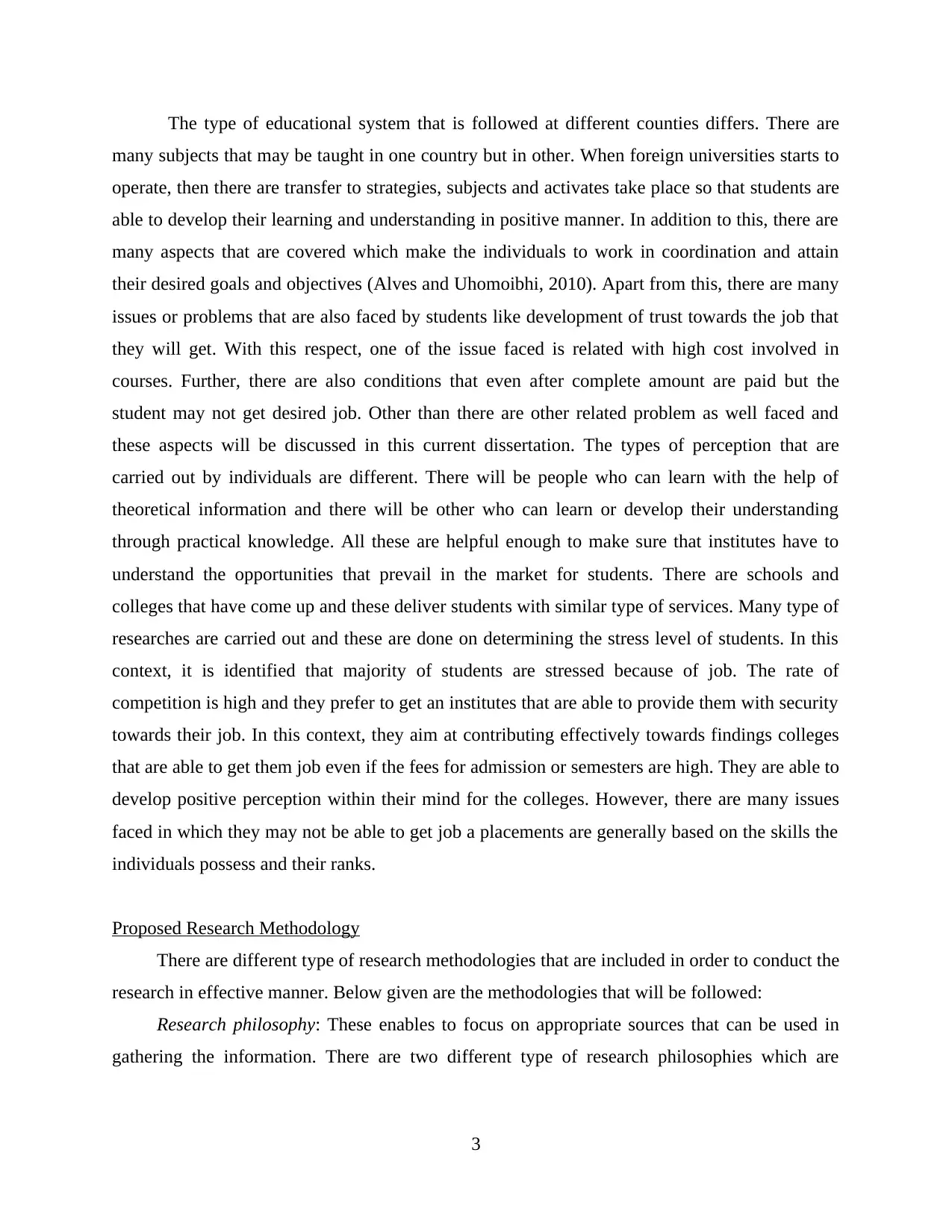
The type of educational system that is followed at different counties differs. There are
many subjects that may be taught in one country but in other. When foreign universities starts to
operate, then there are transfer to strategies, subjects and activates take place so that students are
able to develop their learning and understanding in positive manner. In addition to this, there are
many aspects that are covered which make the individuals to work in coordination and attain
their desired goals and objectives (Alves and Uhomoibhi, 2010). Apart from this, there are many
issues or problems that are also faced by students like development of trust towards the job that
they will get. With this respect, one of the issue faced is related with high cost involved in
courses. Further, there are also conditions that even after complete amount are paid but the
student may not get desired job. Other than there are other related problem as well faced and
these aspects will be discussed in this current dissertation. The types of perception that are
carried out by individuals are different. There will be people who can learn with the help of
theoretical information and there will be other who can learn or develop their understanding
through practical knowledge. All these are helpful enough to make sure that institutes have to
understand the opportunities that prevail in the market for students. There are schools and
colleges that have come up and these deliver students with similar type of services. Many type of
researches are carried out and these are done on determining the stress level of students. In this
context, it is identified that majority of students are stressed because of job. The rate of
competition is high and they prefer to get an institutes that are able to provide them with security
towards their job. In this context, they aim at contributing effectively towards findings colleges
that are able to get them job even if the fees for admission or semesters are high. They are able to
develop positive perception within their mind for the colleges. However, there are many issues
faced in which they may not be able to get job a placements are generally based on the skills the
individuals possess and their ranks.
Proposed Research Methodology
There are different type of research methodologies that are included in order to conduct the
research in effective manner. Below given are the methodologies that will be followed:
Research philosophy: These enables to focus on appropriate sources that can be used in
gathering the information. There are two different type of research philosophies which are
3
many subjects that may be taught in one country but in other. When foreign universities starts to
operate, then there are transfer to strategies, subjects and activates take place so that students are
able to develop their learning and understanding in positive manner. In addition to this, there are
many aspects that are covered which make the individuals to work in coordination and attain
their desired goals and objectives (Alves and Uhomoibhi, 2010). Apart from this, there are many
issues or problems that are also faced by students like development of trust towards the job that
they will get. With this respect, one of the issue faced is related with high cost involved in
courses. Further, there are also conditions that even after complete amount are paid but the
student may not get desired job. Other than there are other related problem as well faced and
these aspects will be discussed in this current dissertation. The types of perception that are
carried out by individuals are different. There will be people who can learn with the help of
theoretical information and there will be other who can learn or develop their understanding
through practical knowledge. All these are helpful enough to make sure that institutes have to
understand the opportunities that prevail in the market for students. There are schools and
colleges that have come up and these deliver students with similar type of services. Many type of
researches are carried out and these are done on determining the stress level of students. In this
context, it is identified that majority of students are stressed because of job. The rate of
competition is high and they prefer to get an institutes that are able to provide them with security
towards their job. In this context, they aim at contributing effectively towards findings colleges
that are able to get them job even if the fees for admission or semesters are high. They are able to
develop positive perception within their mind for the colleges. However, there are many issues
faced in which they may not be able to get job a placements are generally based on the skills the
individuals possess and their ranks.
Proposed Research Methodology
There are different type of research methodologies that are included in order to conduct the
research in effective manner. Below given are the methodologies that will be followed:
Research philosophy: These enables to focus on appropriate sources that can be used in
gathering the information. There are two different type of research philosophies which are
3
Paraphrase This Document
Need a fresh take? Get an instant paraphrase of this document with our AI Paraphraser
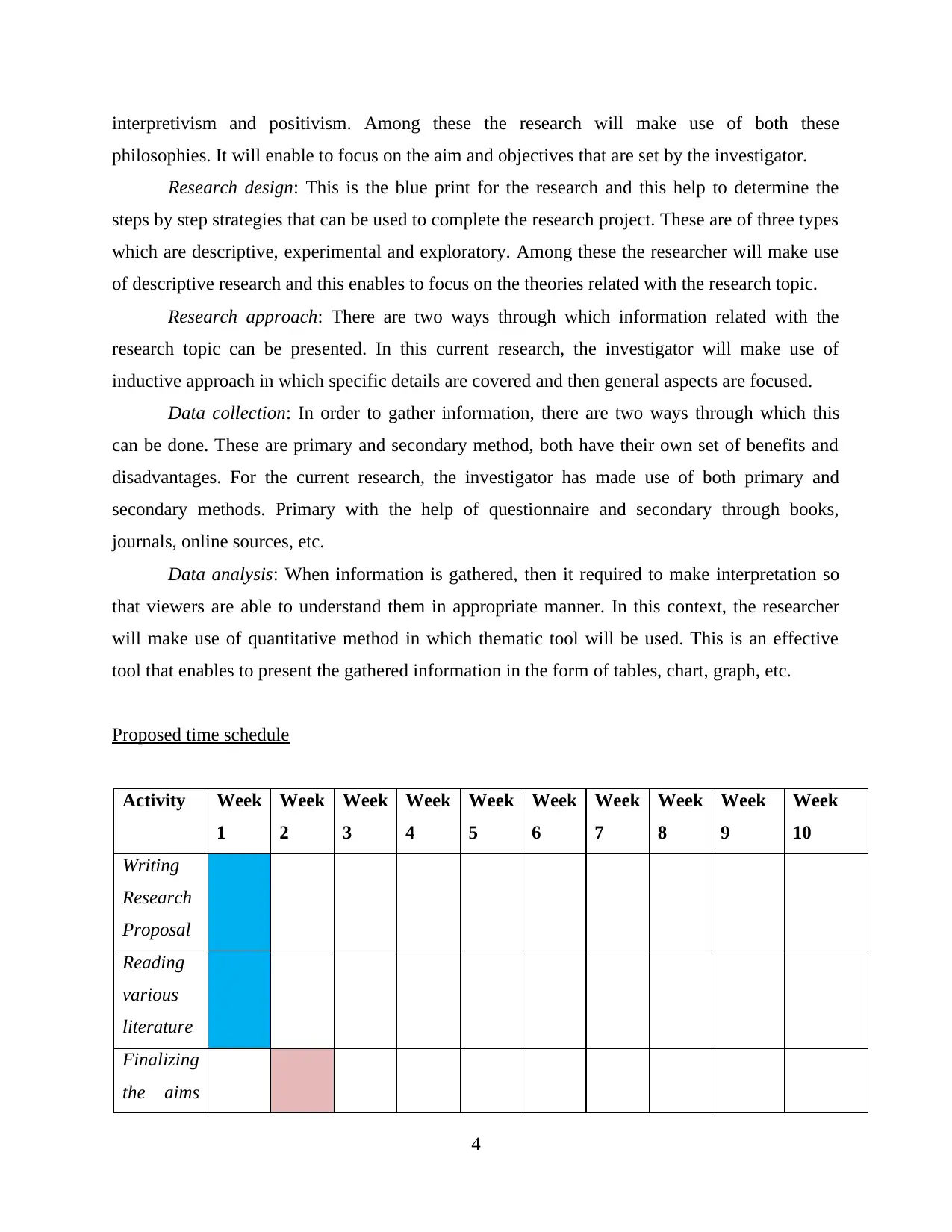
interpretivism and positivism. Among these the research will make use of both these
philosophies. It will enable to focus on the aim and objectives that are set by the investigator.
Research design: This is the blue print for the research and this help to determine the
steps by step strategies that can be used to complete the research project. These are of three types
which are descriptive, experimental and exploratory. Among these the researcher will make use
of descriptive research and this enables to focus on the theories related with the research topic.
Research approach: There are two ways through which information related with the
research topic can be presented. In this current research, the investigator will make use of
inductive approach in which specific details are covered and then general aspects are focused.
Data collection: In order to gather information, there are two ways through which this
can be done. These are primary and secondary method, both have their own set of benefits and
disadvantages. For the current research, the investigator has made use of both primary and
secondary methods. Primary with the help of questionnaire and secondary through books,
journals, online sources, etc.
Data analysis: When information is gathered, then it required to make interpretation so
that viewers are able to understand them in appropriate manner. In this context, the researcher
will make use of quantitative method in which thematic tool will be used. This is an effective
tool that enables to present the gathered information in the form of tables, chart, graph, etc.
Proposed time schedule
Activity Week
1
Week
2
Week
3
Week
4
Week
5
Week
6
Week
7
Week
8
Week
9
Week
10
Writing
Research
Proposal
Reading
various
literature
Finalizing
the aims
4
philosophies. It will enable to focus on the aim and objectives that are set by the investigator.
Research design: This is the blue print for the research and this help to determine the
steps by step strategies that can be used to complete the research project. These are of three types
which are descriptive, experimental and exploratory. Among these the researcher will make use
of descriptive research and this enables to focus on the theories related with the research topic.
Research approach: There are two ways through which information related with the
research topic can be presented. In this current research, the investigator will make use of
inductive approach in which specific details are covered and then general aspects are focused.
Data collection: In order to gather information, there are two ways through which this
can be done. These are primary and secondary method, both have their own set of benefits and
disadvantages. For the current research, the investigator has made use of both primary and
secondary methods. Primary with the help of questionnaire and secondary through books,
journals, online sources, etc.
Data analysis: When information is gathered, then it required to make interpretation so
that viewers are able to understand them in appropriate manner. In this context, the researcher
will make use of quantitative method in which thematic tool will be used. This is an effective
tool that enables to present the gathered information in the form of tables, chart, graph, etc.
Proposed time schedule
Activity Week
1
Week
2
Week
3
Week
4
Week
5
Week
6
Week
7
Week
8
Week
9
Week
10
Writing
Research
Proposal
Reading
various
literature
Finalizing
the aims
4
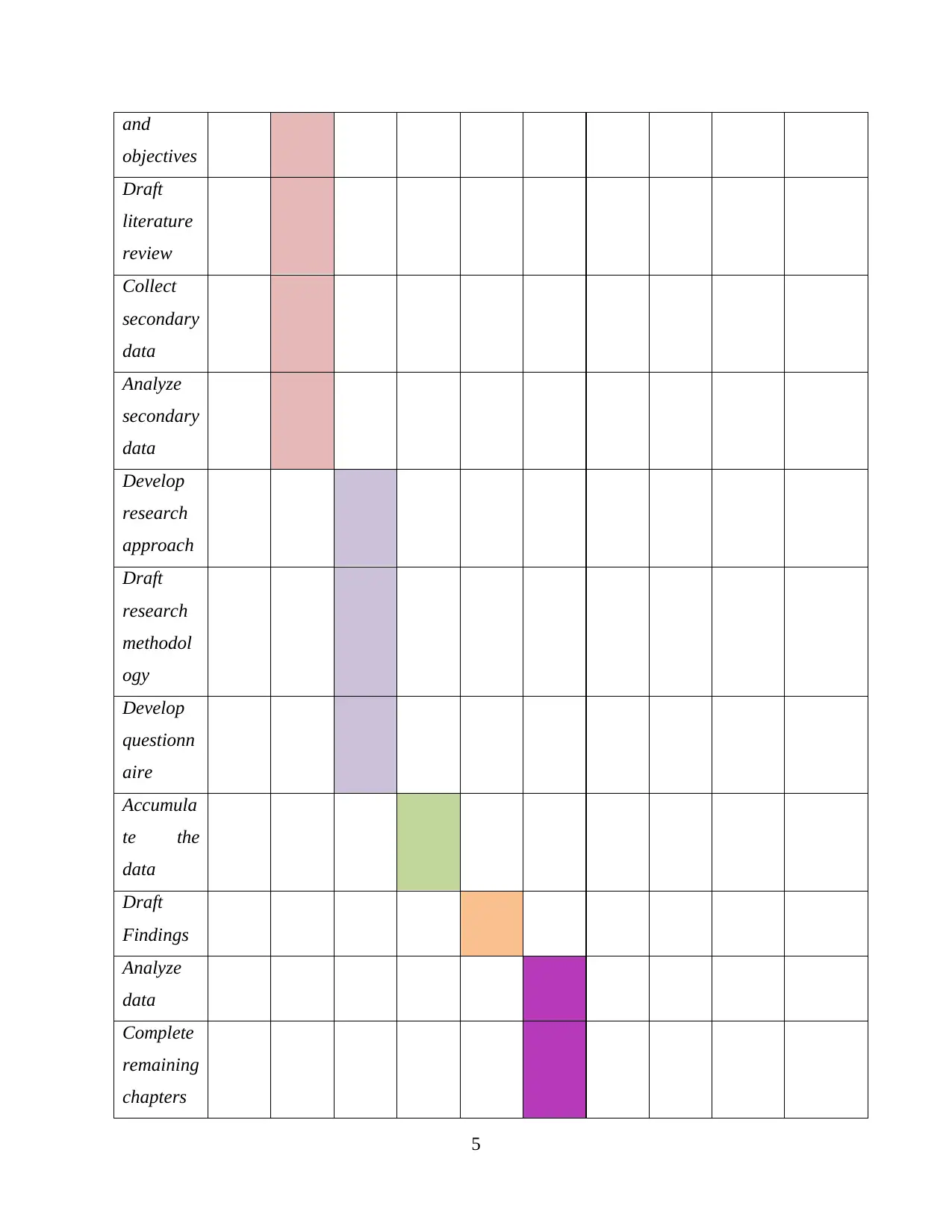
and
objectives
Draft
literature
review
Collect
secondary
data
Analyze
secondary
data
Develop
research
approach
Draft
research
methodol
ogy
Develop
questionn
aire
Accumula
te the
data
Draft
Findings
Analyze
data
Complete
remaining
chapters
5
objectives
Draft
literature
review
Collect
secondary
data
Analyze
secondary
data
Develop
research
approach
Draft
research
methodol
ogy
Develop
questionn
aire
Accumula
te the
data
Draft
Findings
Analyze
data
Complete
remaining
chapters
5
⊘ This is a preview!⊘
Do you want full access?
Subscribe today to unlock all pages.

Trusted by 1+ million students worldwide
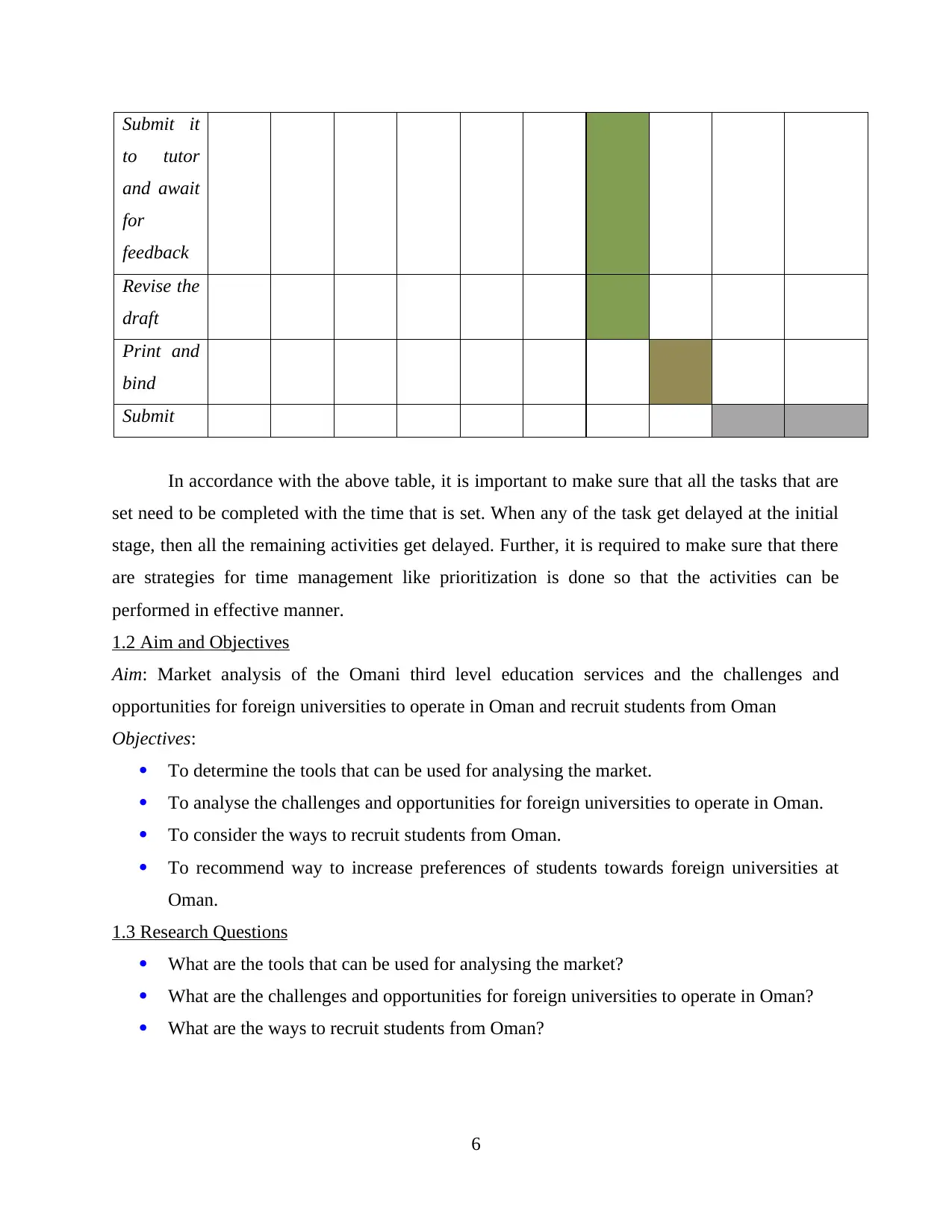
Submit it
to tutor
and await
for
feedback
Revise the
draft
Print and
bind
Submit
In accordance with the above table, it is important to make sure that all the tasks that are
set need to be completed with the time that is set. When any of the task get delayed at the initial
stage, then all the remaining activities get delayed. Further, it is required to make sure that there
are strategies for time management like prioritization is done so that the activities can be
performed in effective manner.
1.2 Aim and Objectives
Aim: Market analysis of the Omani third level education services and the challenges and
opportunities for foreign universities to operate in Oman and recruit students from Oman
Objectives:
To determine the tools that can be used for analysing the market.
To analyse the challenges and opportunities for foreign universities to operate in Oman.
To consider the ways to recruit students from Oman.
To recommend way to increase preferences of students towards foreign universities at
Oman.
1.3 Research Questions
What are the tools that can be used for analysing the market?
What are the challenges and opportunities for foreign universities to operate in Oman?
What are the ways to recruit students from Oman?
6
to tutor
and await
for
feedback
Revise the
draft
Print and
bind
Submit
In accordance with the above table, it is important to make sure that all the tasks that are
set need to be completed with the time that is set. When any of the task get delayed at the initial
stage, then all the remaining activities get delayed. Further, it is required to make sure that there
are strategies for time management like prioritization is done so that the activities can be
performed in effective manner.
1.2 Aim and Objectives
Aim: Market analysis of the Omani third level education services and the challenges and
opportunities for foreign universities to operate in Oman and recruit students from Oman
Objectives:
To determine the tools that can be used for analysing the market.
To analyse the challenges and opportunities for foreign universities to operate in Oman.
To consider the ways to recruit students from Oman.
To recommend way to increase preferences of students towards foreign universities at
Oman.
1.3 Research Questions
What are the tools that can be used for analysing the market?
What are the challenges and opportunities for foreign universities to operate in Oman?
What are the ways to recruit students from Oman?
6
Paraphrase This Document
Need a fresh take? Get an instant paraphrase of this document with our AI Paraphraser
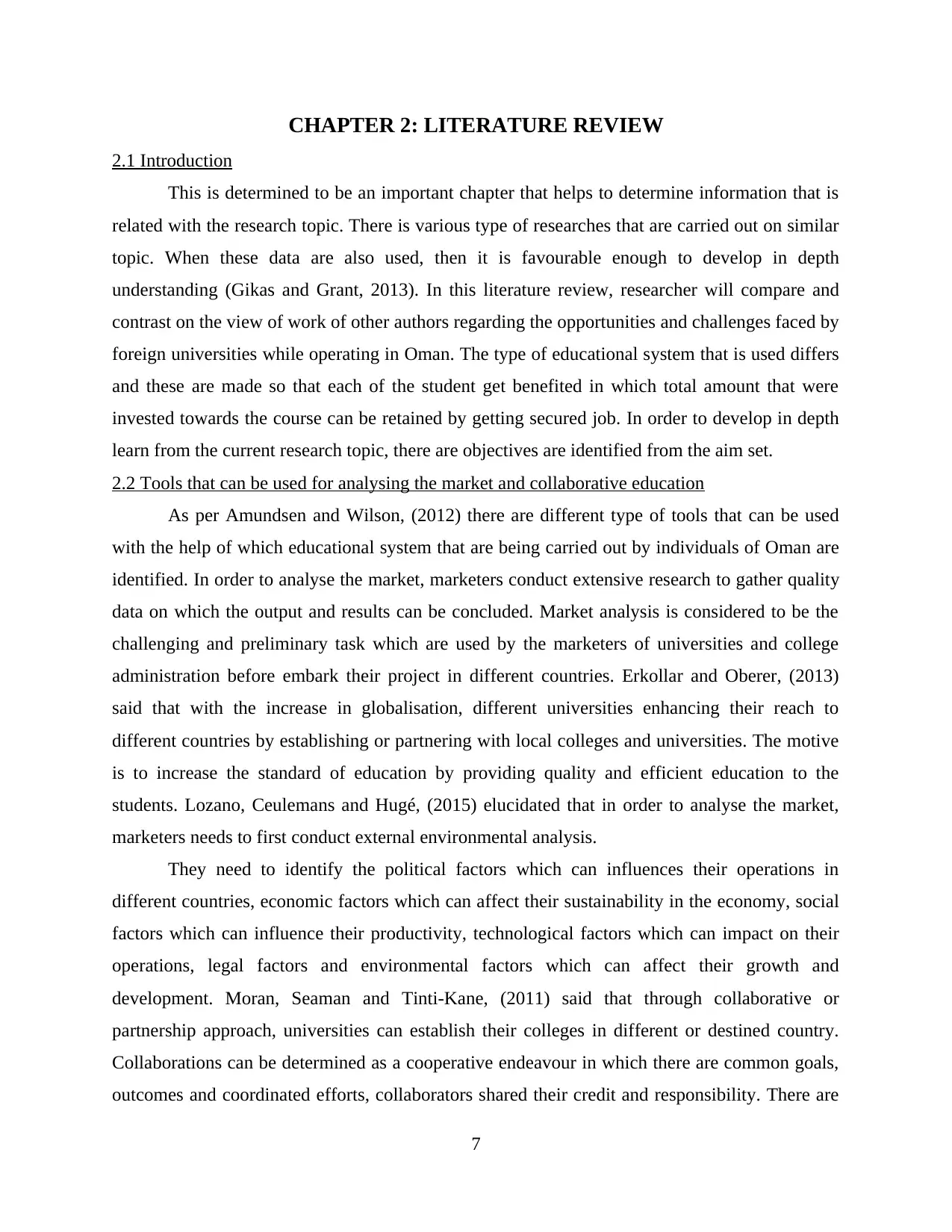
CHAPTER 2: LITERATURE REVIEW
2.1 Introduction
This is determined to be an important chapter that helps to determine information that is
related with the research topic. There is various type of researches that are carried out on similar
topic. When these data are also used, then it is favourable enough to develop in depth
understanding (Gikas and Grant, 2013). In this literature review, researcher will compare and
contrast on the view of work of other authors regarding the opportunities and challenges faced by
foreign universities while operating in Oman. The type of educational system that is used differs
and these are made so that each of the student get benefited in which total amount that were
invested towards the course can be retained by getting secured job. In order to develop in depth
learn from the current research topic, there are objectives are identified from the aim set.
2.2 Tools that can be used for analysing the market and collaborative education
As per Amundsen and Wilson, (2012) there are different type of tools that can be used
with the help of which educational system that are being carried out by individuals of Oman are
identified. In order to analyse the market, marketers conduct extensive research to gather quality
data on which the output and results can be concluded. Market analysis is considered to be the
challenging and preliminary task which are used by the marketers of universities and college
administration before embark their project in different countries. Erkollar and Oberer, (2013)
said that with the increase in globalisation, different universities enhancing their reach to
different countries by establishing or partnering with local colleges and universities. The motive
is to increase the standard of education by providing quality and efficient education to the
students. Lozano, Ceulemans and Hugé, (2015) elucidated that in order to analyse the market,
marketers needs to first conduct external environmental analysis.
They need to identify the political factors which can influences their operations in
different countries, economic factors which can affect their sustainability in the economy, social
factors which can influence their productivity, technological factors which can impact on their
operations, legal factors and environmental factors which can affect their growth and
development. Moran, Seaman and Tinti-Kane, (2011) said that through collaborative or
partnership approach, universities can establish their colleges in different or destined country.
Collaborations can be determined as a cooperative endeavour in which there are common goals,
outcomes and coordinated efforts, collaborators shared their credit and responsibility. There are
7
2.1 Introduction
This is determined to be an important chapter that helps to determine information that is
related with the research topic. There is various type of researches that are carried out on similar
topic. When these data are also used, then it is favourable enough to develop in depth
understanding (Gikas and Grant, 2013). In this literature review, researcher will compare and
contrast on the view of work of other authors regarding the opportunities and challenges faced by
foreign universities while operating in Oman. The type of educational system that is used differs
and these are made so that each of the student get benefited in which total amount that were
invested towards the course can be retained by getting secured job. In order to develop in depth
learn from the current research topic, there are objectives are identified from the aim set.
2.2 Tools that can be used for analysing the market and collaborative education
As per Amundsen and Wilson, (2012) there are different type of tools that can be used
with the help of which educational system that are being carried out by individuals of Oman are
identified. In order to analyse the market, marketers conduct extensive research to gather quality
data on which the output and results can be concluded. Market analysis is considered to be the
challenging and preliminary task which are used by the marketers of universities and college
administration before embark their project in different countries. Erkollar and Oberer, (2013)
said that with the increase in globalisation, different universities enhancing their reach to
different countries by establishing or partnering with local colleges and universities. The motive
is to increase the standard of education by providing quality and efficient education to the
students. Lozano, Ceulemans and Hugé, (2015) elucidated that in order to analyse the market,
marketers needs to first conduct external environmental analysis.
They need to identify the political factors which can influences their operations in
different countries, economic factors which can affect their sustainability in the economy, social
factors which can influence their productivity, technological factors which can impact on their
operations, legal factors and environmental factors which can affect their growth and
development. Moran, Seaman and Tinti-Kane, (2011) said that through collaborative or
partnership approach, universities can establish their colleges in different or destined country.
Collaborations can be determined as a cooperative endeavour in which there are common goals,
outcomes and coordinated efforts, collaborators shared their credit and responsibility. There are
7
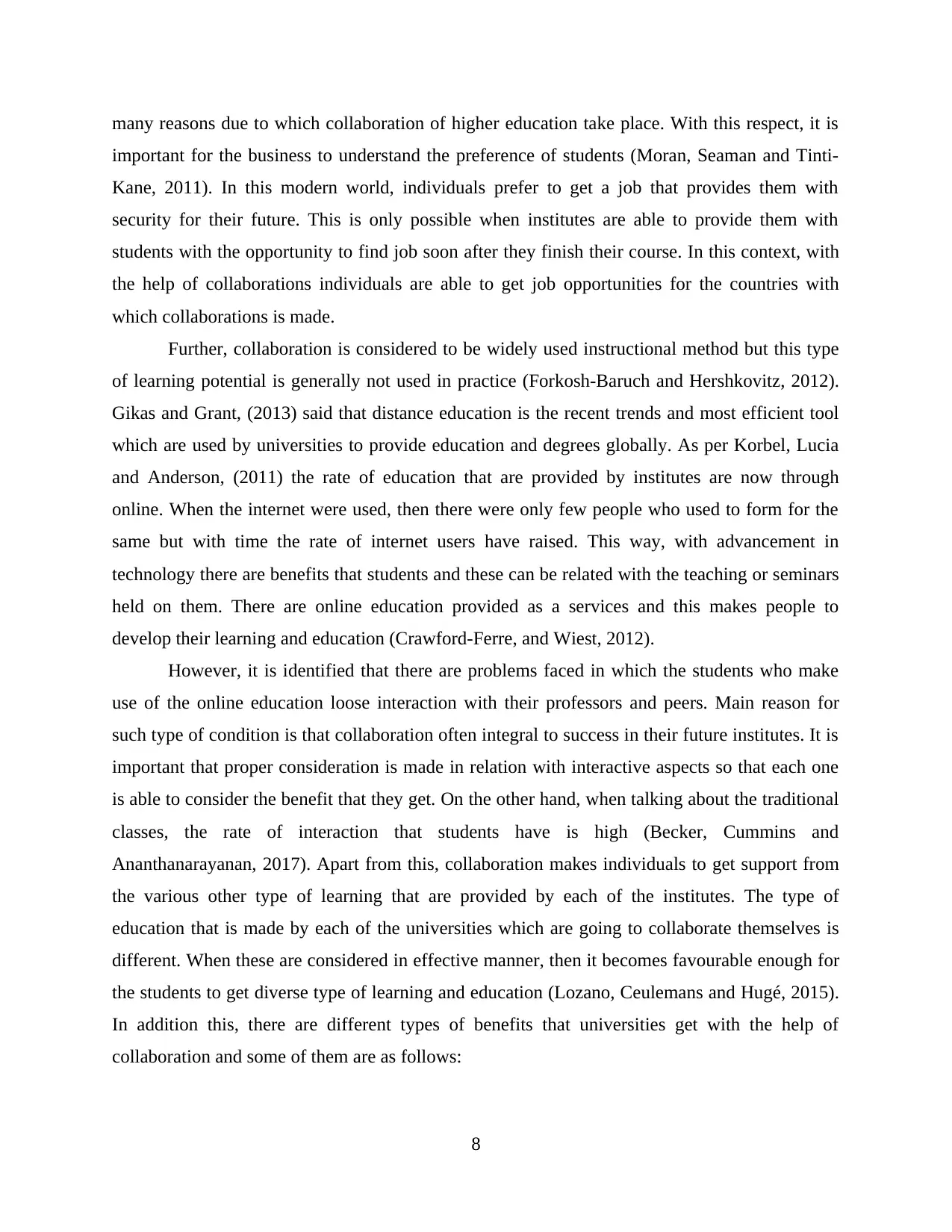
many reasons due to which collaboration of higher education take place. With this respect, it is
important for the business to understand the preference of students (Moran, Seaman and Tinti-
Kane, 2011). In this modern world, individuals prefer to get a job that provides them with
security for their future. This is only possible when institutes are able to provide them with
students with the opportunity to find job soon after they finish their course. In this context, with
the help of collaborations individuals are able to get job opportunities for the countries with
which collaborations is made.
Further, collaboration is considered to be widely used instructional method but this type
of learning potential is generally not used in practice (Forkosh-Baruch and Hershkovitz, 2012).
Gikas and Grant, (2013) said that distance education is the recent trends and most efficient tool
which are used by universities to provide education and degrees globally. As per Korbel, Lucia
and Anderson, (2011) the rate of education that are provided by institutes are now through
online. When the internet were used, then there were only few people who used to form for the
same but with time the rate of internet users have raised. This way, with advancement in
technology there are benefits that students and these can be related with the teaching or seminars
held on them. There are online education provided as a services and this makes people to
develop their learning and education (Crawford-Ferre, and Wiest, 2012).
However, it is identified that there are problems faced in which the students who make
use of the online education loose interaction with their professors and peers. Main reason for
such type of condition is that collaboration often integral to success in their future institutes. It is
important that proper consideration is made in relation with interactive aspects so that each one
is able to consider the benefit that they get. On the other hand, when talking about the traditional
classes, the rate of interaction that students have is high (Becker, Cummins and
Ananthanarayanan, 2017). Apart from this, collaboration makes individuals to get support from
the various other type of learning that are provided by each of the institutes. The type of
education that is made by each of the universities which are going to collaborate themselves is
different. When these are considered in effective manner, then it becomes favourable enough for
the students to get diverse type of learning and education (Lozano, Ceulemans and Hugé, 2015).
In addition this, there are different types of benefits that universities get with the help of
collaboration and some of them are as follows:
8
important for the business to understand the preference of students (Moran, Seaman and Tinti-
Kane, 2011). In this modern world, individuals prefer to get a job that provides them with
security for their future. This is only possible when institutes are able to provide them with
students with the opportunity to find job soon after they finish their course. In this context, with
the help of collaborations individuals are able to get job opportunities for the countries with
which collaborations is made.
Further, collaboration is considered to be widely used instructional method but this type
of learning potential is generally not used in practice (Forkosh-Baruch and Hershkovitz, 2012).
Gikas and Grant, (2013) said that distance education is the recent trends and most efficient tool
which are used by universities to provide education and degrees globally. As per Korbel, Lucia
and Anderson, (2011) the rate of education that are provided by institutes are now through
online. When the internet were used, then there were only few people who used to form for the
same but with time the rate of internet users have raised. This way, with advancement in
technology there are benefits that students and these can be related with the teaching or seminars
held on them. There are online education provided as a services and this makes people to
develop their learning and education (Crawford-Ferre, and Wiest, 2012).
However, it is identified that there are problems faced in which the students who make
use of the online education loose interaction with their professors and peers. Main reason for
such type of condition is that collaboration often integral to success in their future institutes. It is
important that proper consideration is made in relation with interactive aspects so that each one
is able to consider the benefit that they get. On the other hand, when talking about the traditional
classes, the rate of interaction that students have is high (Becker, Cummins and
Ananthanarayanan, 2017). Apart from this, collaboration makes individuals to get support from
the various other type of learning that are provided by each of the institutes. The type of
education that is made by each of the universities which are going to collaborate themselves is
different. When these are considered in effective manner, then it becomes favourable enough for
the students to get diverse type of learning and education (Lozano, Ceulemans and Hugé, 2015).
In addition this, there are different types of benefits that universities get with the help of
collaboration and some of them are as follows:
8
⊘ This is a preview!⊘
Do you want full access?
Subscribe today to unlock all pages.

Trusted by 1+ million students worldwide
1 out of 60
Related Documents
Your All-in-One AI-Powered Toolkit for Academic Success.
+13062052269
info@desklib.com
Available 24*7 on WhatsApp / Email
![[object Object]](/_next/static/media/star-bottom.7253800d.svg)
Unlock your academic potential
Copyright © 2020–2025 A2Z Services. All Rights Reserved. Developed and managed by ZUCOL.





